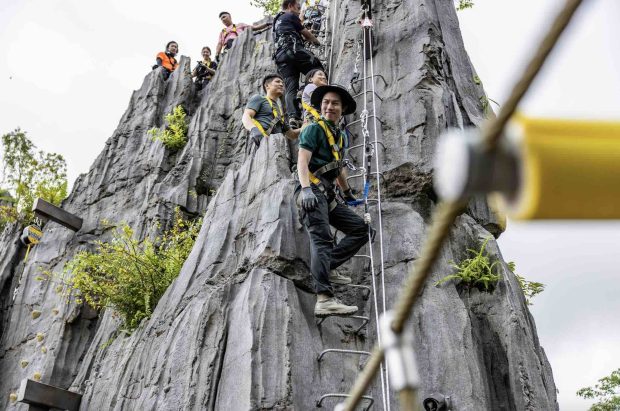When choosing a remote working destination, there are many factors to consider. Many towns and cities are more digital nomad-friendly than others, so it’s essential to do your homework. A set of criteria comes into play when choosing my next destination, and it is as follows:
- Safety
- Internet speed/reliability
- Cost of living
- Lifestyle
- Attractive visa options
- Expat community
Here’s a list of popular remote work towns and cities based on my experience and the digital nomad community.
1. Chiang Mai, Thailand
Chiang Mai tops the list for many a digital nomad and is thus a hugely popular destination. It’s easy to see why. Located in the north of Thailand amongst the jungle, the beautiful landscape allows you to live and work in harmony with nature. You have the surrounding jungle, mountains, and the Ping River to keep you at peace.
Chiang Mai is also a city rich in history and culture, having served as the capital of the Lanna Kingdom until 1558. There’s an abundance of historical buildings, temples, and other structures. This balance of maintaining its cultural roots and low cost of living while welcoming foreign freelancers and remote workers makes Chiang Mai unique.
There are plenty of coworking spaces in Chiang Mai and great neighbourhoods to live in, including Old City, Chang-Dong, Nieman, and Hang Dong.
Thailand also offers an attractive tourist visa option allowing for a stay of up to nine months inside a year.
2. Medellin, Colombia
Once the drug trafficking capital of the world and illegitimately run by Pablo Escobar, Medellin has come a long way from its cocaine cartel heydays. The Wall Street Journal named Medellin 2013’s Innovative City of the Year. Pre-COVID, it was one of the most popular digital nomad destinations. A mini-metropolis surrounded by jungle, mountains, and an ideal moderate climate, it’s easy to see why.
The city has a relatively low cost of living, excellent café culture, and a solid infrastructure for remote working. Moreover, Colombia has a lovely visa-free three-month stay for many passports. It’s also reasonably easy to extend your stay/visa, and there’s word that a Colombian digital nomad visa is on the way.
The main downside to Medellin is safety. Although the previous story about having my drink spiked happened in Cartagena, it can happen anywhere in Colombia. Be street smart and keep your eyes open. The nightlife is next-level, but don’t go out alone. Have someone else with you so you can watch each other’s back.
El Poblado is the neighbourhood to live in. You can turn a corner and find yourself in a patch of jungle full of high-rise apartment buildings and hotels. Like most of my favourite cities, Medellin has an outstanding balance of urbanism and nature, with world-class hiking barely a fifteen-minute drive from the city centre. It‘s a shame the most naturally beautiful cities, Cape Town, Rio de Janeiro, and Medellin, are also some of the most dangerous. That said, as long as you’re street smart, not a dickhead and observe cartagena colombia safety, you should be fine.
3. Tbilisi, Georgia
Despite the ongoing conflict happening next door, Tbilisi in Georgia remains an attractive destination for remote workers. A city steeped in rich history and culture also has a meagre cost of living. What’s more, American, Aussie, UK, and other citizens can stay in Georgia visa-free for one year!
Tbilisi’s appeal doesn’t stop there, and it has excellent internet speeds and coworking hubs galore. The cuisine is fantastic, and the locals are super-friendly (except for Russians, maybe).
Perhaps most importantly, safety and security are as good as it gets. For the best experience, stay in Sarburtalo, which benefits from being close to both Lisi Lake and the city.
4. Cape Town, South Africa
As previously stated, Cape Town is one of my favourite cities and is also popular with the remote working community. The main reason is that it’s one of the most naturally beautiful cities in the world. It has the perfect blend of metropolis and nature. The city is built around Table Mountain National Park. You can get from downtown to a world-class hiking trail in under 15 minutes.
Cape Town is also incredibly cheap and has excellent quality local beef and wine that you can dine on for about a third of the US or Western EU prices. It has a great wine region, Constantia, in the middle of the city, and excellent beaches, including surf. Then there are the weekends away to do some of the best safaris in Africa at Kruger National Park.
The only thing letting Cape Town down is that the internet can be hit and miss and the crime rate. Regarding the latter, although most crime happens in townships, you still must remain vigilant. You can’t just pull out your iPhone willy-nilly, and you shouldn’t go out at night alone. Always have someone else so you can watch each other’s back.
The current tourism visa allows for a stay of up to 90 days. However, the South African Government has plans to offer some form of digital nomad visa shortly.
5. Dubrovnik, Croatia
Croatia, another country embracing the digital nomad, has a relatively low cost of living compared to most European states. Dubrovnik is a beautiful and ancient Adriatic seaside town you may recognize as King’s Landing from Game of Thrones. If old town cobblestone streets, castle-like architecture, and relaxed Mediterranean vibes are your thing, Dubrovnik could be your calling.
Wi-Fi is widely available, and internet speeds are decent. However, one thing to note is that Dubrovnik is a tourist destination, so it can get busy, especially during the summer months. This also means there aren’t many coworking spaces in the city, but there are plenty of Wi-Fi cafés, and your Airbnb, hotel, or hostel will suffice. Dubrovnik has great nightlife as a tourist hub, but I advise not going out alone but with a travel buddy.
For a more relaxed and less touristy vibe, head down the coast to Cavtat. Shh, it’s a secret.
Depending on your passport, you can stay up to 90 days visa-free in Croatia. If you wish to stay longer, you can apply for a temporary residence permit geared toward digital nomads and remote workers.
6. Rio de Janeiro, Brazil
Rio de Janeiro is another of my personal favourites. It’s not surprising, as it reminds me of Cape Town’s natural beauty, beaches, and high crime rate. You can also get from downtown into hiking trails amongst rainforests in under 15 minutes. Like Table Mountain in Cape Town, trekking up to the Christ the Redeemer statue offers incredible views over the city.
Internet speeds are decent and getting faster. However, Brazil is probably the least affordable of the South American countries, yet still has a lower cost of living than most western countries.
Also, like Cape Town, there’s a massive wealth gap, and you will find townships here also. They’re called favelas in Portuguese. I remember hang-gliding off the top of a mountain and looking down at beautiful mansions in a rainforest-suburb setting. Then, only a few hundred meters away, was a favela built into the side of a mountain. The contrast was incredible.
As such, you need to keep your wits about you here too. I recommend staying in Ipanema Beach rather than Copacabana, and it’s safer, more chilled out, and a nicer beach overall.
The other attractive option for Brazil is their new digital nomad visa, with a duration of up to one year and only proof of annual income of US $18,000. One year allows ample time to explore other parts of this massive country, including Florianópolis, Ilha Grande, Sao Paolo, and the Amazon.
7. Penang, Malaysia
Penang, also known as the Pearl of the Orient, is a famous work from anywhere locale due to its excellent food, low cost of living, and relaxed lifestyle and culture. Georgetown, in particular, is a cool place to base yourself. It also has an incredible history and was listed as a UNESCO World Heritage site in 2008.
The internet is decent in Penang, and there’s an abundance of coworking spaces and cool cafés with reliable Wi-Fi. Penang is also generally cleaner, safer, and the people friendlier than most other parts of Malaysia.
One of the best things about Penang is that roughly a 30-minute drive from Georgetown, you’ll find some of Malaysia’s best and most pristine beaches. This combination of unique city culture and relaxed beach vibes makes Penang special.
The other stand-out feature is the food, and it’s next-level. If you’re a foodie and love the beach and trendy inner-city living, Georgetown, Penang, could be for you.
8. Lisbon, Portugal
Lisbon has rapidly risen as a digital nomad destination in the last five years. As a result, it has a young, entrepreneurial and energetic vibe. Besides being a calm and cultured city, the cost of living is low by Western European standards and while not as cheap as smaller Portuguese towns, it won’t break the bank.
Like Europe, Lisbon has incredible historical architecture and beautiful sightseeing. After a long day working in front of your computer, taking a stroll around the city is the perfect winddown. It also has an inclusive community welcoming freelancers and remote workers. That’s an understatement; the people are some of the nicest on the planet. The other main advantage is Spain; the Mediterranean is next door to explore for weekends away. Or France, or any of Western Europe, for that matter.
Additionally, Portugal has an attractive Temporary Stay visa that allows you to live in the country for up to one year. If you fall in love with the country (or a person) you can apply for Residency (D7) visa.
The best neighbourhoods to live in are Alfama, Principe Real, Cais do Sodre, Barrio Alto, and the more budget-friendly Santos.
9. Playa Del Carmen, Mexico
Another location on the rise for remote working is the Playa Del Carmen in Mexico. Located halfway between Cancun and Tulum on the Caribbean coast, it has some of the world’s most exquisite coastlines and beaches. Playa Del Carmen has speedy Wi-Fi, making video conferencing, programming, and most online work a breeze. Walk into any café, and you might find another digital nomad working away.
The cost of living is well below countries such as the US, UK, and Australia. You can get an inexpensive rental within walking distance of one of the world-class beaches. Food is excellent and cheap, too, with plenty of tasty street food options for under five bucks.
Playa Del Carmen is also a water sports lovers’ paradise, with paddle boarding, kite-surfing, and jet skiing, among other activities, widely available. Then there are the ancient ruins sitting on the edges of cliffs with the clear aquamarine water sitting below. It truly is an incredible place.
Also appealing is that Mexico offers a 180-day visa-free stay for many passports, including the US, UK, Ireland, Australia, New Zealand, Japan, and most EU countries.
10. Budapest, Hungary
Hungary’s internet is consistently ranked in the top ten fastest speeds worldwide, so remote work reliability is not a problem. Furthermore, free Wi-Fi is widely available in cafés and other establishments. And if you need a coworking space, there are plenty around. If there’s a country on the list that wins the best prize for connectivity, Hungary is it.
Budapest is its capital city and, like most of Europe, is full of incredible architecture, history, and culture. The cost of living is relatively low, yet the stand of living is very high. It’s also more chilled out than most other European cities. However, there’s vibrant nightlife should you seek it out.
As of 2022, Hungary has released a new digital nomad visa which, should you meet the requirements, allows you to live and work in the country for a year, with the ability to extend. This should make it even more famous for digital nomads than it already is.
For the best areas to set up camp, explore Districts 1, 5, 6, 7, 13, and for the more budget-friendly District 9.
11. Bali, Indonesia
Bali, Indonesia, is one of the original and most popular digital nomad destinations. There are many reasons for this. Bali has fairly relaxed visa requirements for many passports, which attracts citizens worldwide.
There’s something for everyone in Bali. If you like the hustle and bustle and party life, you can stay in Kuta. Alternatively, if you’re more of a chilled-out vibes kind, Canguu could be for you. Seminyak offers a trendy and hedonistic vibe with excellent beach clubs. At the same time, Ubud in the jungle caters to your spiritual and yogi types. There’s also perfect surf in Bali, especially on the outer reefs. If you’re the resort type, head to Nusa Dua.
Internet connectivity is decent, with most cafés offering free Wi-Fi. Walk into most restaurants, and you’ll likely find other digital nomads drinking coffee and bashing the keyboard.
Bali is also very affordable; you can secure a lovely villa with a private pool in a fabulous neighborhood for surprisingly little. Additionally, you can explore other parts of the island during your time off, including Nusa Lembongan, Nusa Penida, and not-so-secret waterfalls.
Author: Tim Roberts is a freelance writer, blogger, and author of Goodbye Office, Hello World: How to become a digital nomad.







